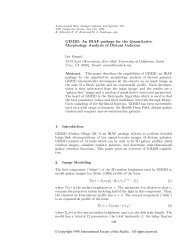4 Comparison of the ALMA and Herschel - ESO
4 Comparison of the ALMA and Herschel - ESO
4 Comparison of the ALMA and Herschel - ESO
Create successful ePaper yourself
Turn your PDF publications into a flip-book with our unique Google optimized e-Paper software.
Figure 17: Images <strong>of</strong> emission from IRC+10216 from <strong>the</strong> species identified in <strong>the</strong> upper left corner <strong>of</strong><br />
each panel. The contours are <strong>the</strong> integrated intensities. IRC+10216 is a solar mass star on <strong>the</strong> Asymptotic<br />
Giant Branch (AGB). Images from Lucas et al., 1995.<br />
The high spatial resolution, large FOV <strong>and</strong> good sensitivity <strong>of</strong> <strong>Herschel</strong> will lead to great<br />
progress in our underst<strong>and</strong>ing <strong>of</strong> <strong>the</strong> mass loss process in evolved stars, <strong>the</strong> time evolution<br />
<strong>of</strong> <strong>the</strong> mass loss rate, how it influences <strong>the</strong> sha ping <strong>of</strong> <strong>the</strong> surrounding nebula, properties<br />
<strong>of</strong> <strong>the</strong> dust formed <strong>and</strong> <strong>the</strong> formation site <strong>of</strong> <strong>the</strong> dust. Spectra <strong>of</strong> AGB stars <strong>and</strong> PNe are<br />
ideal tracers <strong>of</strong> solid <strong>and</strong> molecular species that form in <strong>the</strong> cool circumstellar envelope.<br />
Most <strong>of</strong> <strong>the</strong> astronomical solid state features are found in <strong>the</strong> near <strong>and</strong> mid-infrared range.<br />
However, dust species like Forsterite Mg 2<br />
SiO 4<br />
at 69 µm (a sensitive dust <strong>the</strong>rmometer),<br />
Calicite (CaCO 3<br />
) at 92.6 µm, crystalline water-ice at 61 µm, <strong>and</strong> o<strong>the</strong>r dust species <strong>and</strong> ices<br />
will be measured by <strong>Herschel</strong> in our galaxy <strong>and</strong> o<strong>the</strong>r nearby galaxies. In addition in some<br />
circumstellar envelopes, powerful H 2<br />
O <strong>and</strong> SiO masers are present. These will be easily<br />
detected with <strong>ALMA</strong>. <strong>ALMA</strong> can image <strong>the</strong> SiO quasi-<strong>the</strong>rmal millimetre line emission<br />
in <strong>the</strong> outflows <strong>of</strong> <strong>the</strong> stars. With distance from <strong>the</strong> star, <strong>the</strong> SiO molecule first freezes out<br />
onto dust grains as <strong>the</strong> temperature drops; fur<strong>the</strong>r still, SiO is photodissociated by <strong>the</strong> interstellar<br />
UV-radiation field. Measurements <strong>of</strong> SiO, when combined with CO line emission<br />
will be used to follow <strong>the</strong> envelope evolution (gas expansion <strong>and</strong> acceleration) within 20-30<br />
stellar radii. These data will provide a database <strong>of</strong> dust formation <strong>and</strong> evolved-star physics<br />
that will be used as a template to study <strong>the</strong> spectra <strong>of</strong> high-redshift galaxies that will be<br />
targeted with <strong>ALMA</strong>.<br />
40




